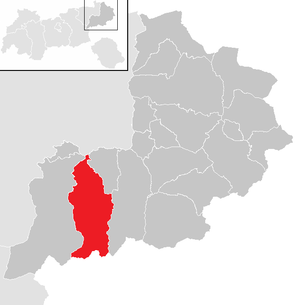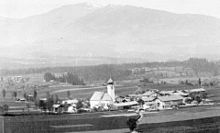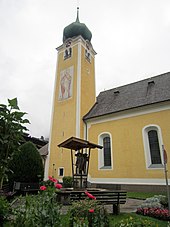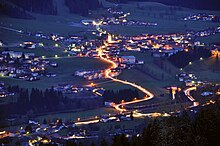Westendorf (Tyrol)
|
Westendorf
|
||
|---|---|---|
| coat of arms | Austria map | |
|
|
||
| Basic data | ||
| Country: | Austria | |
| State : | Tyrol | |
| Political District : | Kitzbühel | |
| License plate : | KB | |
| Surface: | 95.41 km² | |
| Coordinates : | 47 ° 26 ' N , 12 ° 13' E | |
| Height : | 783 m above sea level A. | |
| Residents : | 3,684 (Jan 1, 2020) | |
| Postal code : | 6363 | |
| Area code : | 05334 | |
| Community code : | 7 04 20 | |
| NUTS region | AT335 | |
| Address of the municipal administration: |
Dorfplatz 1 6363 Westendorf |
|
| Website: | ||
| politics | ||
| Mayoress : | Annemarie Plieseis (WE with Annemarie Plieseis) | |
|
Municipal Council : (2016) (15 members) |
||
| Location of Westendorf in the Kitzbühel district | ||
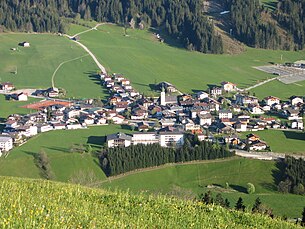 View from Salvenberg to the village center |
||
| Source: Municipal data from Statistics Austria | ||
Westendorf is an Austrian municipality with 3684 inhabitants (as of January 1, 2020) in Brixental in Tyrol . The municipality is located in the judicial district and district of Kitzbühel .
geography
Geographical location
Westendorf lies on a sunny terrace in the Brixental Valley, at the foot of the Choralpe. The community area consists of a clustered village and other hamlets and farms in the area, as well as an industrial area. The Windau valley branches off to the south and is a popular local recreation area.
A large part of the municipality is forested or used for agriculture.
Community structure
|
structure
|
||||||
|
Legend for the breakdown table
|
Rivers
The Brixentaler Ache and the Windauer Ache flow through the municipality.
mountains
Important mountains are: the Hohe Salve ( 1828 m ), the Steinbergstein ( 2215 m ), the Kröndlhorn ( 2444 m ) and the Brechhorn ( 2032 m ).
Neighboring communities
Westendorf is bordered by three communities in the Kitzbühel district, one in the Kufstein district and two in the Zell am See district .
| Söll | ||
| Hopfgarten in Brixental |

|
Brixen im Thale Kirchberg in Tirol |
| Wald im Pinzgau and Neukirchen am Großvenediger |
history
The first finds in Westendorf go back to the Bronze Age , whereby the cremation graves were destroyed during the construction of Bahnhofstrasse in 1926. The finds that were made back then are now in the Landesmuseum Ferdinandeum . The artifacts have several peculiarities: On the one hand there is a considerable amount of them, on the other hand some of the objects found are made of bronze that does not come from Tyrol .
In Roman times, Westendorf belonged to the province of Noricum , with the place right on the border. 476 of this province was Odoaker dissolved, and thus probably many inhabitants to neighboring Rätien crossed over.
Westendorf was first mentioned in a document in 1234, in a donation from Count Otto von Wasserburg to the Rott Monastery . But there are indications that the place and the church already existed earlier: In 902 the noble Rodolt, a royal official, handed over his property in Brixental to the bishop of Regensburg . In order to be able to enforce their own claim against the Bishop of Brixen , it can be assumed that the Regensburg bishops built a church in the area near Westendorf. Furthermore, the church is consecrated to Nicholas of Myra , which indicates that it was erected in the 11th and 12th centuries. Century.
At the Fourth Lateran Council , the founding of the Chiemsee diocese was decided in 1215. This new diocese was also assigned the entire Brixental, with the Bishop of Chiemsee having sovereign and spiritual power, while the Archbishop of Salzburg had the right to patronage and tithes. In 1385 the Brixental came completely to the Archdiocese of Salzburg as a result of a purchase contract , but the spiritual rights remained with the Diocese of Chiemsee.
The St. Nicholas Church in Westendorf was first mentioned in a document in 1320. The Gothic building was rebuilt in 1771 by André Huber.
Westendorf was subordinate to the Itter court , to which Emperor Maximilian I transferred the high level of jurisdiction in 1514 . In the 16th century there was lively mining around Westendorf, in the 16th and 17th centuries copper, galena and sulfur pyrites were mined in the Windau valley .
In 1803 the Archdiocese of Salzburg came to the Grand Duchy of Tuscany as a result of the secularization propagated by Napoleon and to Austria in 1805. In 1809 Salzburg, like Tyrol, came to Bavaria, and it was not until 1814 that it came back to Austria.
On May 1, 1816, the entire Brixental came to Tyrol according to a resolution by Emperor Franz I , whereby Westendorf was raised to an independent municipality in the same year.
Section
fortification of Burgegg: Today you can find Höfe near Westendorf with the names "Burwegen" and "Burweg". If you look at the map in this area, you will find a plateau bordered by streams, which would have been suitable for a fortress due to its location. If it was previously assumed that this was a prehistoric fortification, today it is assumed that there was a medieval earth castle with wooden parts on the site. Unfortunately, neither remains of the wall nor other finds were made in the area, and there are no written sources on the complex.
Religions
In the 2001 census , around 90% of the population professed Catholicism . The rest is attributable to other religions and non-denominational groups .
Population development

At the 2011 census Westendorf had 3597 inhabitants, the number of inhabitants is constantly increasing.
politics
Mayor and community council
The Westendorf community board consists of five members.
- Mayor Annemarie Plieseis, We with Annemarie Plieseis
- Deputy Mayor Walter Leitner-Hölzl, Mayor List for Employees, Economy and Tourism
- Community board member Leonhard Schroll Citizen list for agriculture, tourism and employees
- Community chairman Michael Vorderwinkler, we with Annemarie Plieseis
- Local councilor Johann Krall, citizen list for agriculture, tourism and employees
Municipal council
The municipal council consists of 15 members and has been made up of mandates from the following parties / lists since the 2016 municipal council election:
- WIR with Annemarie Plieseis - the mayor provides: 5 mandates
- Aufwind - Citizens' list for agriculture, tourism and workers provides the Vice Mayor: 5 mandates
- List of mayors for employees, business and tourism: 3 mandates
- Westendorfer Wirtschaft: 2 mandates
Worth mentioning:
The mayor list, as well as the peasant list and the list of Westendorf's economy were linked in the last municipal council election in 2010. These three lists can be assigned to the ÖVP.
In the 2016 municipal council elections, the rural list was voted out, the mayor list lost four seats, and Westendorf's economy lost one seat. The two new parties running for election, WIR with Annemarie Plieseis and Aufwind - Citizens' List for Agriculture, Tourism and Employees , entered the municipal council with five seats each. A runoff election was planned for March 13, 2016 between mayor Anton Margreiter and mayor candidate Annemarie Plieseis, with Margreiter resigning and resigning before the election. Ms. Plieseis thus became the new mayor of Westendorf.
The Westendorf power list entered the 2004 municipal council elections as the “General Westendorf List (SPÖ)”.
coat of arms
The coat of arms was awarded in 1954 by the Tyrolean provincial government.
Blazon :
- “Split; in front a golden bishop in black, with the right a bishop's staff, in the left holding three balls, in the back split by silver and red. "
The bishop's figure depicts Saint Nicholas as the local parish patron. The state colors white (silver) and red indicate that the congregation only came to Tyrol in 1816 as a result of the Congress of Vienna .
Culture and sights
Site design
As part of the European “ Entente Florale Europe ” competition, Westendorf was awarded a gold medal in the village category and the title “Most beautiful green and blooming village in Europe” by an international jury in 1998.
buildings
- Roman Catholic Parish Church of St. Nicholas : The Gothic church is first mentioned in a document in 1320. The church was rebuilt towards the end of the 15th century; after a fire in 1630, the church was restored and redesigned in Baroque style in 1735. Over time, the church has been rebuilt and renovated several times.
music
In addition to the Westendorf Federal Music Band, there are numerous folk music groups. There has also been a church choir for a long time.
Sports
There are numerous facilities available to residents and guests for sports:
- Heated outdoor swimming pool
- Tennis courts
- Beach volleyball courts
- Minigolf Plant
- Mountain bike routes
- Biking and hiking trails
- Nordic walking routes
- Air rifle shooting range
- Fitness course
- Soccer fields
- Riding arena, trotting track
- Numerous ski slopes, mainly with artificial snow, monocable gondolas, chair lifts, drag lifts and baby lifts
- Ice rink
- Cross-country trails
- Paragliding in the Wilder Kaiser area
- 3D archery course
- Golf course (18 holes)
Part of the “Kaiser-Runde”, a long-distance cycle path that starts and ends in Kufstein , is the otherwise low-traffic valley of the Windauer Ache, which is lively used by many cyclists in the warm season.
Economy and Infrastructure
Apart from tourism, Westendorf's economy is mainly characterized by smaller commercial enterprises. There are many out-commuters in the municipality (590 in 2001). In contrast, there were only 273 in-commuters.
tourism
Westendorf is mainly geared towards tourism in two seasons. In winter Westendorf is a popular winter sports resort with numerous lifts and ski slopes. In addition, the local ski area is a member of SkiWelt Wilder Kaiser - Brixental , the largest connected ski area in Austria. In summer Westendorf is a very good starting point for long hikes and excursions into the grass mountains of the Kitzbühel Alps .
In the 2004 calendar year the community had 424,297 overnight stays. Of these, 166,214 (39.2%) were in the summer season and 258,083 (60.8%) in the winter season. The municipality of Westendorf was in 29th place in the number of overnight stays across Tyrol (2004). In 2004 there were around 3800 guest beds available to tourists.
In addition to the sporting facilities, there are also the following tourist facilities:
- Alpinolino adventure park
- Campsite in the Mühltal
traffic
Westendorf can be reached via the Salzburg-Tiroler-Bahn and Brixentalstrasse B 170. There is a motorway connection via the Inntal motorway A 12 with the Wörgl -Ost exit .
media
Since January 1985, the Westendorfer Boten, a monthly village newspaper, has been published by the Westendorf parish and the Westendorf adult school. It is available to the community as well as to all associations and institutions and is distributed free of charge to all households.
Public facilities
- Building yard
- Community library
- Community Guard
- Sewage treatment plant, together with the neighboring municipality of Brixen im Thale
- Composting plant
- Event center Alpenrosensaal
- Residential and nursing home
education
- kindergarten
- Elementary school
- New middle school (former secondary school), together with the neighboring municipality of Brixen im Thale
- Alpine school - school of seeing and feeling
- Adult school
Personalities
Honorary citizen
- 1990: Josef Schönacher , former mayor, holder of the Golden Merit Badge of the Republic of Austria
Sons and daughters
- Josef Mitterer (* 1948), professor of philosophy at the University of Klagenfurt
- Michael Baur (* 1969), professional footballer (Bundesliga club LASK )
- Silvia Berger (* 1980), ski racer ( ÖSV )
- Thomas Zass (* 1989), volleyball professional in the 1st Bundesliga, VC Amstetten
- Martin Achrainer (* 1978) opera singer
Personalities associated with the community
- Sepp Kahn (* 1952), Brixental dialect poet from Itter (spends the summers as a dairy farmer on an alpine pasture in the Windau valley )
Web links
- 70420 - Westendorf. Community data, Statistics Austria .
- Westendorf , in the history database ofthe association "fontes historiae - sources of history"
- Westendorf gigapixel panorama (17,200 megapixels)
- Tirol Atlas: Westendorf
Individual evidence
- ↑ Martin Bitschnau , Hannes Obermair : Tiroler Urkundenbuch, II. Department: The documents on the history of the Inn, Eisack and Pustertal valleys. Vol. 1: Up to the year 1140 . Universitätsverlag Wagner, Innsbruck 2009, ISBN 978-3-7030-0469-8 , p. 86-87, no. 117 .
- ↑ Flower Offices Austria
- ↑ Kufsteinerland: Kaiser Tour


